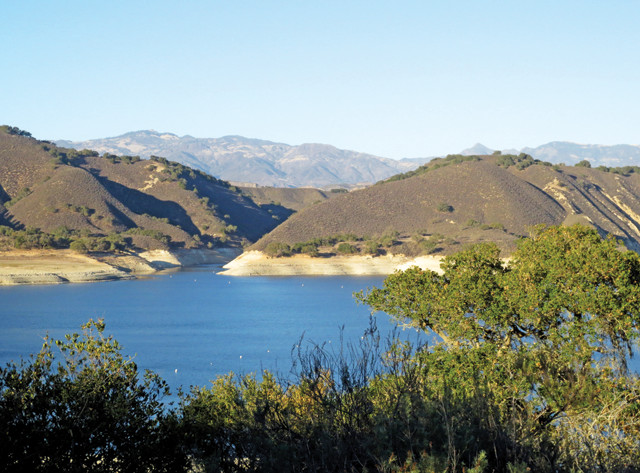
by Fred Schwab Monday, June 8, 2015

Cachuma Reservoir supplies about one-third of the water for Santa Barbara County. It is projected to set a new record-low volume by October. Credit: Claudia Schwab.
“Jack and Jill went up the hill to fetch a pail of water.” So begins the nursery rhyme. In California, it’s apropos, given that so much of the state’s water comes from “up the hill” — meaning the Sierras and Rockies. But due to the ongoing drought, Jack and Jill — or in this case, most of the populated and agricultural regions in the state — may have to come up with another plan.
Determined to escape a Shenandoah Valley winter, my wife and I fled to California late last December. Although we successfully avoided the snow and chill of home, we were continually reminded that in other parts of the country (and the world), the snow at least would have been welcome.
Reminders of the Golden State’s long-term water shortage came frequently, such as when we requested water at restaurants or had to limit the length of our showers. Newspapers updated us almost daily on California’s worst drought in recorded history. Of course, the drought extends across a dozen states inland to southern Texas and the northern Rockies, but thirsty California is hardest hit. By the end of the rainy season in spring 2014, more than two-thirds of the state was under “extreme” drought conditions (the second most severe level designated by the U.S. Drought Monitor) while another quarter was facing “exceptional drought” (the most severe designation). In spring 2015, half of California was in exceptional drought, and that area continues to expand.
Many municipalities have enacted water restrictions, with differing levels of success. On April 1, 2015, Gov. Jerry Brown imposed mandatory statewide water restrictions cutting urban usage by 25 percent compared to 2013 levels. On May 5, the State Water Resources Control Board approved even stricter rules, forcing cities to limit watering of public property, imposing mandatory water-savings targets for water agencies across the state, and encouraging homeowners to let their lawns die. (Half of urban water use goes to landscaping!) However, one has to wonder if these restrictions have teeth, given that many agencies are loathe to issue fines or other sanctions on heavy users.
The California water supply system, designed for 18 million residents, now serves 38 million, with an additional 12 million expected by 2040. But aquifers are being drained: Groundwater supplied 65 percent of the water used in the state in 2014, compared with long-term annual average withdrawal rates of less than 40 percent. In 2014, more than 6.3 cubic kilometers of water were withdrawn from underground reserves. These aquifers may take decades to refill. Reservoirs fed by the melting of the annual Sierra Nevada snowpack have also been largely drained. In 65 years of record-keeping, the snowpack is lower than ever (about 6 percent of normal).
Meanwhile, severe damage extends across the state’s farm belt, which provides one-third of the nation’s food (and about half of our fruits, nuts and vegetables). Surprisingly, agriculture, which consumes almost four-fifths of human water use, is excluded from the restrictions.
On Feb. 27, however, the Central Valley Project, a federal program run by the Bureau of Reclamation, announced it would not release water from reservoirs for most Central Valley farms. This drastically impacts farmers, will lead to higher food prices, and will increase the pressure on the already overexploited groundwater supply.
Numerous other schemes to rectify water shortages are being considered. Water conservation measures should include low-flow plumbing fixtures, high-tech agricultural technologies (such as smarter sprinklers), reverse-osmosis plants for desalination and reprocessing of waste effluent, and construction of additional storage-capture ponds. Some coastal cities, such as Cambria, Santa Barbara and Carlsbad, are already building or reactivating desalination plants.
Los Angeles, notorious for transporting water great distances to supply its growing population, is working toward sustainable water management and has made great strides. Its 3.9 million residents consume less water than did the 2.8 million who lived there in 1970. Its move toward sustainability was forced upon it by restrictions on how much water (still 89 percent) the city could import. Projects are underway to treat and capture polluted water (including sewage effluent) for reuse. The flood-control network, which channels runoff into the Pacific, is being modified to capture, store and treat runoff. As it is fully developed over the next 20 years, the storm-water capture system will supply more than half of the current 0.75 cubic kilometers of water now consumed annually by the city.
California restaurant-goers’ special requests for water are trivial distractions compared with major adjustments in lifestyle that must be undertaken. Efforts to deal with the present drought, as well as additional droughts to come, must involve effective responses not just by Californians, but by Westerners in general. Otherwise, in the future, Jack and Jill’s pail will be filled with little more than dust and broken dreams!
© 2008-2021. All rights reserved. Any copying, redistribution or retransmission of any of the contents of this service without the expressed written permission of the American Geosciences Institute is expressly prohibited. Click here for all copyright requests.